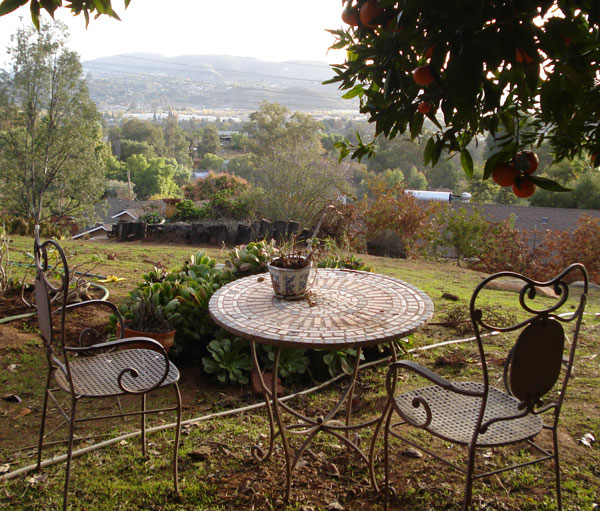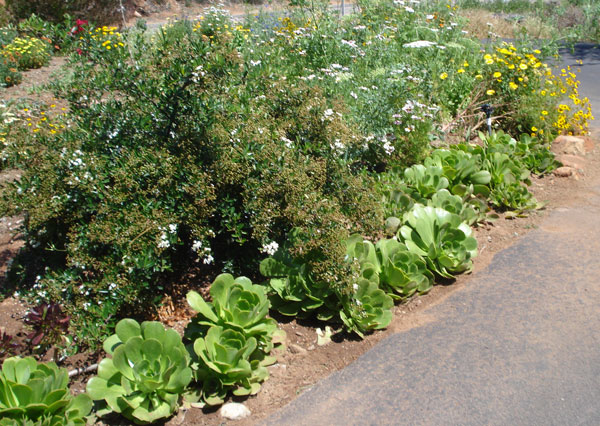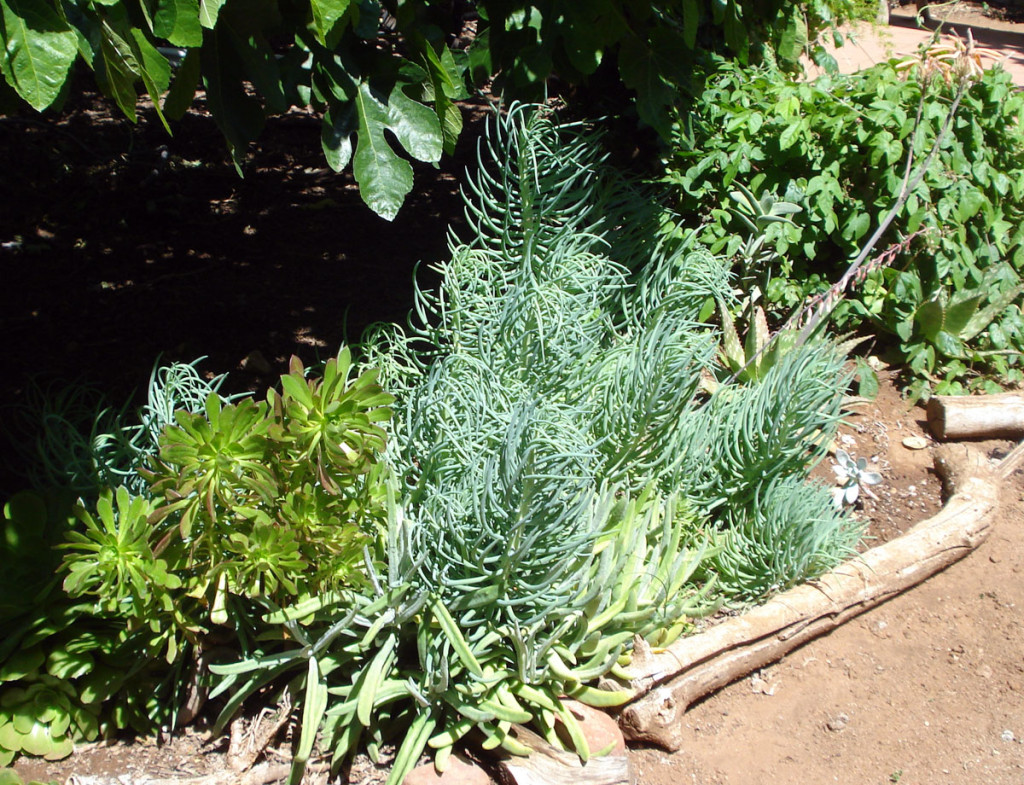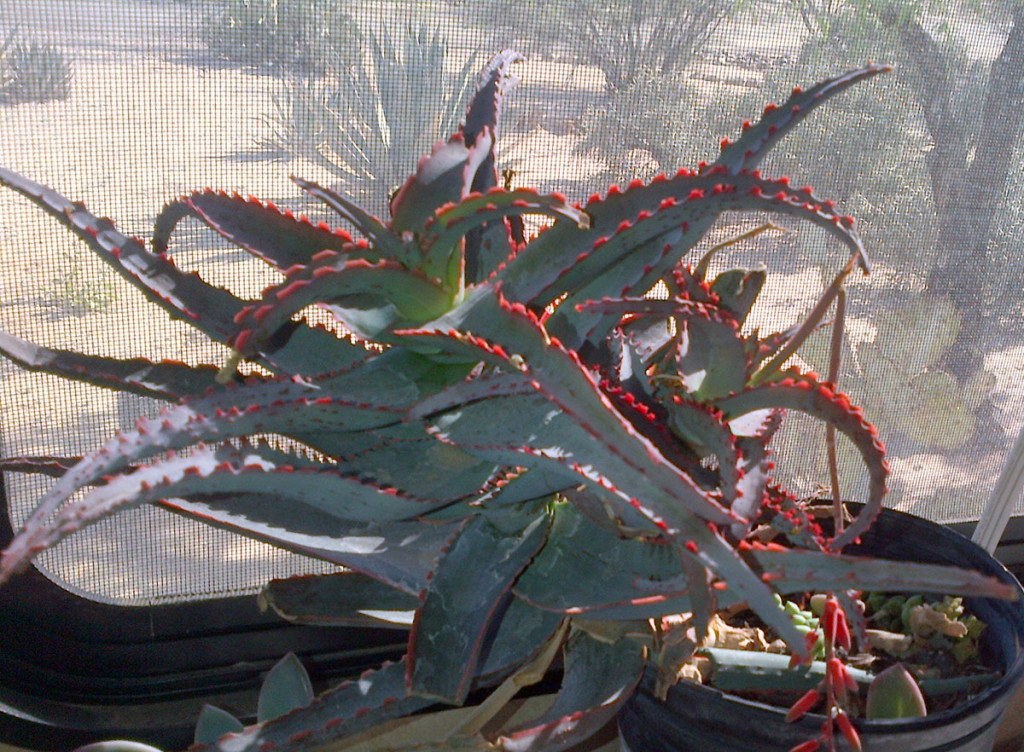Spring flowers abound around my home but more than ever I am delighting in the succulents I planted and propagated last fall. I had one large aeonium in the back that was overgrown with crab grass. So I took it completely out and planted about 30 of its florets as a border around my front circle wildflower garden. They were not this big last fall!
There is something about those giant green florets that I adore. So I decided to learn more about succulents and treated myself to two of our local legend Debra Lee Baldwin‘s books, the kindle versions, for my birthday. First her original book, Designing with Succulents and then her latest book, Succulents Simplified: Growing, Designing, and Crafting with 100 Easy-Care Varieties
. I am delighted with how readable they are in my Ipad kindle app. I can expand the great color photos to look at details and then click on the done button when finished. The pictures are really lovely and the garden designs are amazingly colorful.
Here is what the original aeonium plant looked like, it is behind my little table. It appears to be a bunching variety. Looking through the aeoniums at the David’s garden web site, I think perhaps it is aeonium canariense. It was in a full sun, no extra water, location. The new location gets a brief automated weekly watering and as a result it is much greener and larger.

When I first moved to the San Diego area I had left behind a large lovely jade plant that was just too big to fit with everything else we were taking in the motorhome. So I gave it to my neighbor who had cared for it in our absence. I had nurtured for about 15 years and was very sad to part with it. Imagine my surprise when the house we decided to buy came with many enrmous jade bushes all over the property! And they bloom with little white flowers in the late winter.
My first outing with the Lakeside Garden Club was to a Solano Beach succulent grower. Knowing nothing, I picked a few to try out. Then my garden club friend Margaret gave me a few cuttings. So I put together a small succulent garden as an experiment. Now it is lush and full and I moved a few agave pups to the back … now where to put more succulents? Everywhere!
Recently while visiting friends in Tucson, we went to the Tohono Chul gardens for brunch and the garden shop there had all kinds of lovely succulents. So I became an enabler and encouraged Adrienne to buy enough succulents for 3 pots and helped her plant them. But that will be another blog post … for myself, I fell in love with this Aloe ‘Sunset” and bought it. I still have not decided where to put it however, so it is on a post outside my office sliding doors for now.




I’m a succulent convert and Debra Lee Baldwin fan, too. Her books are the best books on the succulent gardening topic, IMO and the first ones I recommend to anyone wanting to try their hand with succulents in containers or in the garden. I’m trying to include some native CA plants for the birds, butterflies and other wildlife into my low water garden in Encinitas, too, with varying rates of success.
So which natives are successful? Perhaps I should add a few myself. I did plant a california lilac (ceonanthus) which is doing well.
I see that the hummingbirds are perfectly happy with my non-native cape honeysuckle and the butterflies are happy with my wildflower garden (I finally got some milkweed going!)
I’m jealous of your ceanothus. I’ve not been able to get any of the 4 I planted to stay alive on upper part of our steep cut slope. With the low rainfall the past few winters, they simply required more hand watering to get them established than I could manage on that part of the dry, sun-baked, steep slope (Las Pilitas native nursery says natives often can require up to a year of regular watering, even for “drought-tolerant” dry summer CA natives, until they become established).
What the situation with your ceanothus? How do you tend it?
I’ve since learned that many native plants, also do best with the companion plants found in in their native “community”, with the same soil microorganisms, and other features of that community (dry summers, rain in winter, coastal fog drip, etc.) and I hadn’t provided enough of aspects of that community to support them. The native community in Encinitas is predominantly Coastal Sage Scrub. I also learned that some nurseries grow CA natives in coddled nursery conditions with a lot of fertilizer to create natives in full bloom that look great in the garden centers, but then fizzle when planted in the garden because their root structures might not match their above ground growth and can’t fend for themselves when planted. So I’m trying to stick to nurseries like Las Pilitas that are more into growing healthy plants than showy plants for corporate chain store garden centers. And finally, I decided having an upper slope of natives was too much of a challenge for me to tackle well at this time, so I’m putting natives with easier reputations in lower, less steep locations so I can more easily monitor and offer life support when it’s hot & dry until they are well established.
Fragrant Cleveland sages are among my favorite natives. I have two that are not quite one year old in a mixed, occasionally irrigated section of salvias, succulents, and plumerias near the bottom of our slope, and another in a flat mostly sunny area next to my front porch (placed for its fragrance). A fourth one in a berm near my back patio didn’t make it – I think I withdrew life support too early and it fried before I noticed. The hummingbirds love Cleveland sage blooms, and small birds eat the seeds out of the spent flowers, so I left the flower spikes in place until long after it stopped blooming. I just deadheaded and pruned them (saving the leaves for a very nice piney, resinous herbal tea for myself). New growth is already showing, so I’m hopeful these sages are going to do ok.
A couple California fuchsias I planted a couple years ago didn’t make it on the dry steep upper slope, either, but a one gallon size planted on the semi-regularly irrigated but still fairly dry lower slope doubled in size this year and is surviving well enough, though it didn’t bloom very much. It became overshadowed by one of the faster growing Cleveland sages, and it’s very brittle, so I have to be careful not to be rough when I’m working around it.
I have planted a different variety of CA fuchsia in a berm near the patio that isn’t quite so brittle, with larger, really lovely pale green leaves with a silvery shimmer that nicely contrast against the fiery deep salmon colored flowers. A definite hummingbird magnet, this CA fuchsia has nearly finished blooming, so the hummingbirds are looking elsewhere now. Keeping my fingers crossed that I’m watering this CA fuchsia regularly enough to establish its roots while it’s so warm & dry this year. I have a couple more of this variety still in nursery pots (staying cool in the filtered light under the olive tree in our front garden) that I’d like to plant in a very sunny south-facing berm close to the sidewalk, but that berm still needs more work and planning before I’m ready to risk installing the fuchsias.
I’ve got a couple of books on CA natives, but the one that I should have started with is The CA Native Landscape: The Homeowner’s Design Guide to Resorting its Beauty and Balance by Greg Rubin & Lucy Warren. When I read it, I learned some of the reasons why I wasn’t successful with my earlier attempts with CA natives.
Wow you practically wrote a whole blog entry there. Thank you! and thank you for the book recommendation.
Yes my ceonanthus gets watered in this, its first year, in order to get established. It is by a soaker hose that gets automatially turned on once a week for about 15 minutes. I like to use soaker hoses because I can move them around … you might try a few on that upper slope that are connected to a regular hose that you then run water through occasionally.
Soon it will be time to get to work in my garden again, when it cools off inland where we live. Then I will do a blog entry on natives after I read the book and plant some fragrant cleveland sage.
Do you use the Dave’s garden site at all? I rather like it. Here is cleveland sage there: http://davesgarden.com/guides/pf/go/261/